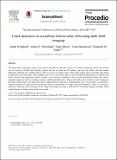Crack detection in crystalline silicon solar cells using dark-field imaging
Author(s)
Wieghold, Sarah; Morishige, Ashley Elizabeth; Meyer, Luke; Buonassisi, Anthony; Sachs, Emanuel Michael
Download1-s2.0-S1876610217341838-main.pdf (991.0Kb)
PUBLISHER_CC
Publisher with Creative Commons License
Creative Commons Attribution
Terms of use
Metadata
Show full item recordAbstract
The high capital expenditure (capex) necessary to manufacture crystalline silicon PV modules negatively affects the levelized cost of electricity (¢/kWh) and critically impacts the rate at which the PV industry can scale up. Wafer, cell, and module fabrication with thin free-standing silicon wafers is one key to reduce capex. Thin wafers reduce capex associated with silicon refining and wafer fabrication, which together sum to 58% of the total capex of silicon module manufacturing. In addition, thin wafers directly and significantly reduce variable costs. However, introducing 50 μm thin free-standing wafers into today's manufacturing lines result in cracking, creating a yield-based disincentive. Due to the brittle nature of silicon, wafer breakage is the major concern due to the high stress that is induced during processes in manufacturing lines. In this paper, we describe an improved method for edge micro-crack detection that can help enable low-capex, thin free-standing Si wafers. We present a method of detecting and measuring cracks along wafer edges by using a dark-field IR scattering imaging technique which enables detection of edge cracks at the micron scale. Keywords: Capex; polysilicon; thin free-standing wafer; edge crack detection; IR scattering; dark-field imaging
Date issued
2017-09Department
Massachusetts Institute of Technology. Department of Mechanical EngineeringJournal
Energy Procedia
Publisher
Elsevier
Citation
Wieghold, Sarah et al. “Crack Detection in Crystalline Silicon Solar Cells Using Dark-Field Imaging.” Energy Procedia 124 (September 2017): 526–531 © The Authors
Version: Final published version
ISSN
1876-6102